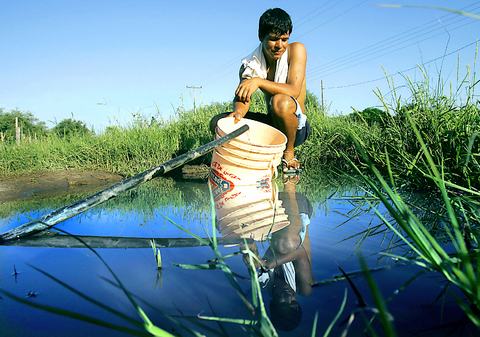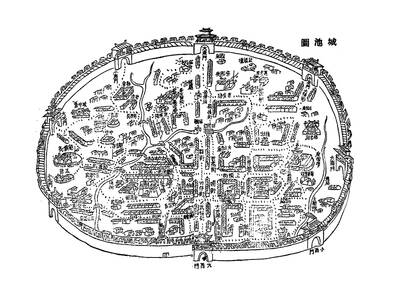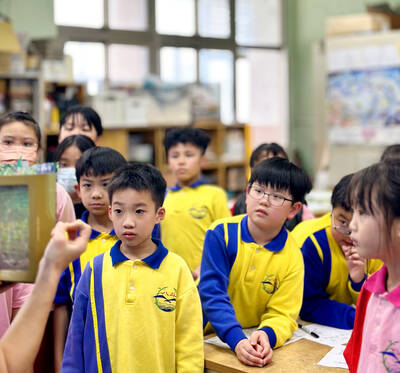Former poacher Zhang Shengyuan was on his way to jail when wildlife rangers decided to give him a job.
A lifelong resident of eastern China's Hongze Lake, Zhang is now a persuasive advocate for sustainable fishing methods and alternative crops that have helped restore part of the heavily polluted lake to its former vitality.
``I've been threatened by some people, even with knives, but I'm not afraid,'' Zhang said on Wednesday at an event marking UN World Water Day in China's commercial hub of Shanghai. ``We're trying to do things right and change our hometown.''

PHOTO: EPA
Zhang's story offers a glimmer of hope in the otherwise grim outlook for China's waterways, so badly fouled by decades of breakneck economic development that 320 million rural residents now lack safe drinking water.
Environmentalists in China and around the world hope observances of World Water Day, first celebrated in 1992, will help draw attention to such problems and prompt potential solutions.
Worldwide, 1.1 billion people lack safe drinking water and 2.6 billion have no access to basic sanitation, according to the UN. Floods and droughts kill more people than any other natural disaster and waterborne diseases such as typhoid kill thousands of children every day.
The UN says it hopes to reduce those numbers by half over the next nine years.
In a message marking World Water Day, the head of UNESCO said a better understanding of traditional water management practices would help guide modern societies to better handle current challenges.
``From prehistoric times until today, humanity's dealings with water have greatly influenced the sustainability of societies,'' UNESCO director general Koichiro Matsuura said in a statement.
About 75 percent of those facing water problems live in Asia.
In Pakistan, the government says population growth and the silting of reservoirs has reduced the amount of water available for agriculture by up to 35 percent.
``We have already started feeling the pinch. The water we need is not there,'' Qamar-uz Zaman Chaudhry, the head of Pakistan's Meteorological Department, said.
Across the border in Indian-controlled Kashmir, water is chronically short despite plentiful natural resources, a result of geography,
geopolitics and regional rivalries that have given Pakistan control over the region's main rivers. Residents of the regional capital Srinagar must line up daily to obtain water from tanker trucks.
A key regional lender, the Asian Development Bank announced this month that it would double spending on water management projects over the next five years.
Those investments aim to provide safe drinking water and improved sanitation for about 200 million people, along with providing better drainage and reducing flood risks for about 140 million more in countries including China, India, Indonesia, Pakistan and Vietnam.
In China, pollution and over-development have destroyed water quality and led to catastrophic flooding.
About 75 percent of the country's industrial waste is dumped untreated into bodies of water, leaving half of the country's rivers and lakes unsuitable for drinking or fishing.
Once-thriving Hongze Lake began deteriorating after economic reforms took hold in the 1980s, said Zhang, looking a little out of place in his ranger's camouflage fatigues amid the ritzy stores and bars of Shanghai's Xintiandi shopping district.
``People just wanted to get rich, so everyone, including me, began using electricity, explosives, poison and all other kinds of damaging methods to catch fish,'' he said.
Hongze Lake is part of a network of water bodies linked to the Yangtze River, China's biggest waterway whose watershed provides fresh water for 400 million people and sustains 70 percent of the country's rice cultivation.
It's also a key area for industry and about 25 billion tons of waste are dumped directly into the river each year.
The World Wildlife Federation (WWF) is seeking to revive marshlands in the river's network of lakes to revive fishing and improve flood protection.
``It's a long process, but this is first step toward healing the Yangtze,'' said Dermont O'Gorman, country director for WWF.

May 26 to June 1 When the Qing Dynasty first took control over many parts of Taiwan in 1684, it roughly continued the Kingdom of Tungning’s administrative borders (see below), setting up one prefecture and three counties. The actual area of control covered today’s Chiayi, Tainan and Kaohsiung. The administrative center was in Taiwan Prefecture, in today’s Tainan. But as Han settlement expanded and due to rebellions and other international incidents, the administrative units became more complex. By the time Taiwan became a province of the Qing in 1887, there were three prefectures, eleven counties, three subprefectures and one directly-administered prefecture, with

It’s an enormous dome of colorful glass, something between the Sistine Chapel and a Marc Chagall fresco. And yet, it’s just a subway station. Formosa Boulevard is the heart of Kaohsiung’s mass transit system. In metro terms, it’s modest: the only transfer station in a network with just two lines. But it’s a landmark nonetheless: a civic space that serves as much more than a point of transit. On a hot Sunday, the corridors and vast halls are filled with a market selling everything from second-hand clothes to toys and house decorations. It’s just one of the many events the station hosts,

Two moves show Taichung Mayor Lu Shiow-yen (盧秀燕) is gunning for Chinese Nationalist Party (KMT) party chair and the 2028 presidential election. Technically, these are not yet “officially” official, but by the rules of Taiwan politics, she is now on the dance floor. Earlier this month Lu confirmed in an interview in Japan’s Nikkei that she was considering running for KMT chair. This is not new news, but according to reports from her camp she previously was still considering the case for and against running. By choosing a respected, international news outlet, she declared it to the world. While the outside world

Through art and storytelling, La Benida Hui empowers children to become environmental heroes, using everything from SpongeBob to microorganisms to reimagine their relationship with nature. “I tell the students that they have superpowers. It needs to be emphasized that their choices can make a difference,” says Hui, an environmental artist and education specialist. For her second year as Badou Elementary’s artist in residence, Hui leads creative lessons on environmental protection, where students reflect on their relationship with nature and transform beach waste into artworks. Standing in lush green hills overlooking the ocean with land extending into the intertidal zone, the school in Keelung